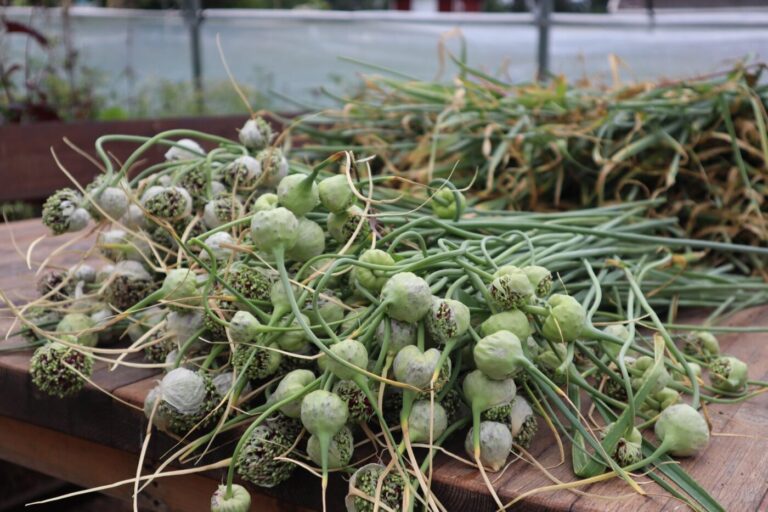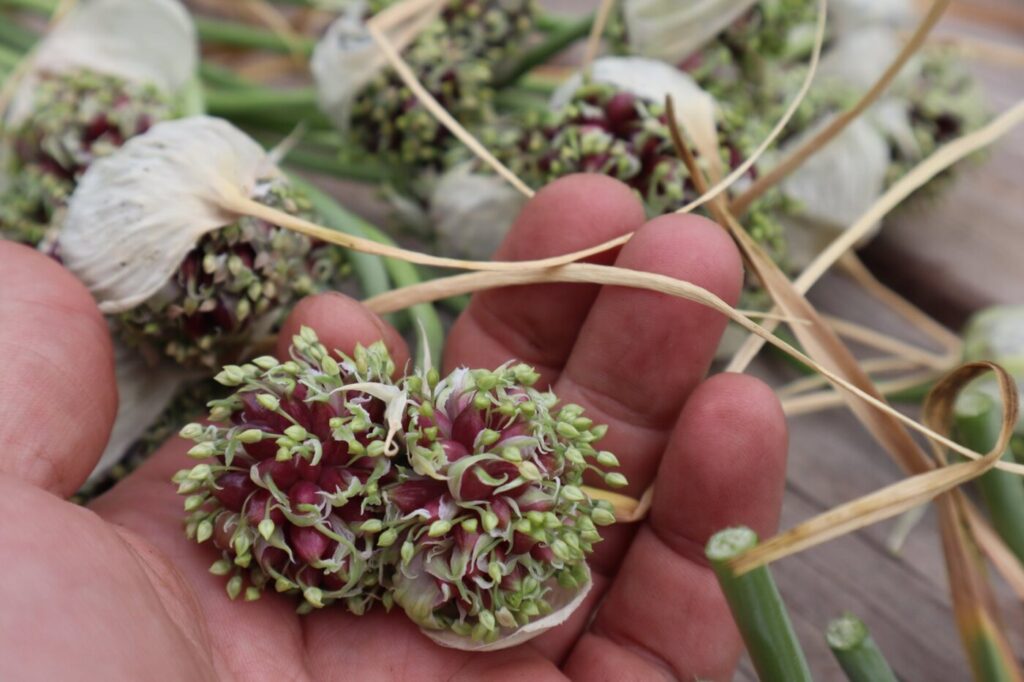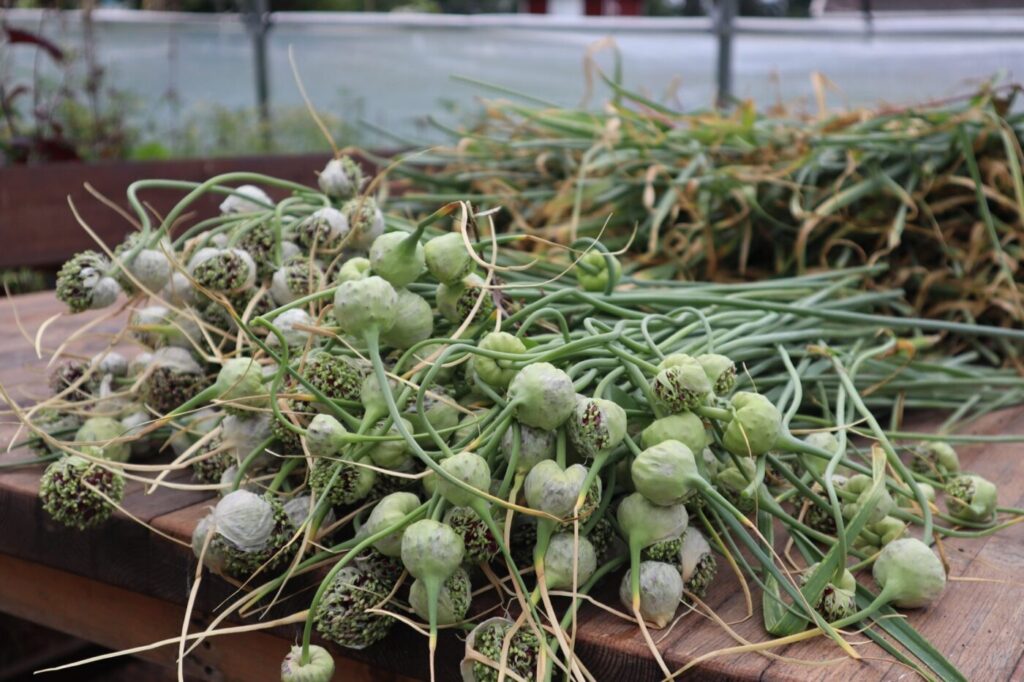As the planet warmed 11,000 years ago, garlic was traded from what is now Kyrgyzstan and Tajikistan throughout Central Asia. Its long shelf life made it one of the earliest tradable items, acting as a form of currency for hunter gathers. It was light weight, tasted great and stored well.
Since the time of the Pharaohs, it had become central to cultures touched by empires, far and wide. When the Children of Israel starved in the Sinai Desert they longed for “the leeks, onions and garlic” of Egypt. Ted Jordan Meredith says that “when we plant, grow, eat, trade and share garlic, we participate in this ancient thread, this ancient relationship between garlic and humankind (The Complete Book of Garlic: 2008).
Diversity within garlic reflects the paths it has taken. There are many Korean, South European, East European, African, and Russian varieties. At some point garlic split into softneck and hardneck kinds. The softnecks came from southern countries, whereas hardneck, being more closely related to the original garlic, comprises the bulk of the diversity.
Since garlic is mostly propagated vegetatively and rarely sexually through flowers and true seed, the soft neck varieties are all clones. The majority of hardneck varieties make bulbils at the end of the neck (scape). We can imagine a primitive ancestor of garlic that flowered like most species in the Allium genus; a trait that it has mostly lost. Since the greatest mechanism for adaptation is sexual reproduction, expert breeders’ cross garlic varieties through special techniques to get “True Garlic Seed”.
For hobby growers and peasants, garlic makes a lot of sense to grow. It is planted in the fall when little else needs to be done on the farm or garden. It is harvested in the late summer, which is generally a slow period between when most of the sowing and weeding is done, and before the big waves of harvesting need to be done. It can be followed by a new wave of plants, ensuring that wherever garlic is planted we get two crops instead of one from that space. It can also be planted on the edge of a bed as it has few leaves and does not compete much for sunlight with the main crop. Any cold hardy plants can be planted in its wake ensuring maximum yield from a small area.
Since Garlic needs a period of cold to form cloves, one plants it in the fall. The planting guide “10, 10, 10” stands for 10cm deep, 10cm apart in October. It should be planted deep enough to ensure that most of the fall growth remains protected from frost, while also getting the needed cold to form cloves.
Garlic is one of the few plants whose roots gradually draw the plant deeper underground. Wild garlic hunters sometimes must give up on digging old plants up as they have simply gone too far down to reach. When a garlic plant is not harvested, you will find several plants growing out of one spot the following year. This is a common trait of alliums, who naturally grow in groups if humans don’t split them up. But moving Alliums is a healthy thing as sickness can build up if they stay too long in one spot. And splitting them up helps give them space to clone all over again.
The general advice is not to grow garlic in the same spot and to always move it, not returning for four years. This avoids fungal and viral sicknesses which vegetatively propagated plants suffer from, being soil bound. A simple but effective method to reduce the pressure of sickness on a population is to reproduce using the plant’s aerial bulbils instead of the cloves. Doing so takes two seasons, instead of the usual seven or eight months that it takes for a clove to become a head. The first season one takes the bulbils and plants them close together at about 2 cm depth. The following year they form “solo garlic” or single clove garlic, which is sometimes found in stores at an inflated price. These are then planted as if they were a clove which then gives a full head the following year.
Another reason garlic spread to so many ancient cultures is the ease with which it is propagated. It comes from harsh climates where winter temperatures frequent -40°C and survives drought, floods, foraging and when deep enough, fire. This makes garlic a great crop for an unstable changing environment in northern countries where we can still get extreme cold, as well as the ever-increasing frequency of global heating waves that stress crops.
Today, 80% of the world’s garlic is grown in China. This is a sad fact, as fresh local garlic is far superior in taste to mass produced and globally transported garlic. Why import a plant as simple to grow as garlic when we can even grow it at 1000 meters above sea level right here in Norway?
I expect an increasing number of hobby growers and farmers to see the value of adding this amazing plant to the diversity of their gardens and farms, reconnecting with Europe´s ancient hunter gatherer past. Once you have a population, you will never have to buy seeds or garlic again. It’s easy to gradually build up stock and it takes next to no time or resources. Small holders say “honey is money” because you can store and trade it for other more perishable goods. The same goes for garlic.
Once you connect with garlic, you are entering the world of Allium Genus, all of which are edible, gorgeous, and hardy. The Norwegian Seed Savers have a world class collection which Stephen Barstow spent a lifetime collecting and is now sharing with members. This video of his Allium collection at the Botanical Gardens showcases that diversity.




